![]() IDEAS
IDEAS
![]() Tweet
Tweet
 Vacation
Rentals
Vacation
Rentals
![]()
|
Made With |
|
|
|
|
Dr. Hoffer's Travel WebSite This site was last updated 02/11/13 |
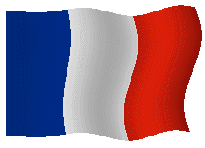
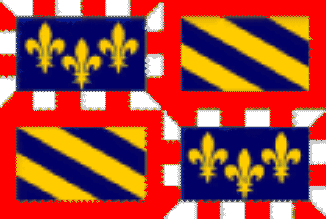
![]() FRAN2005 #38
BURGUNDY
to DIJON
FRAN2005 #38
BURGUNDY
to DIJON
![]()
Flag of Bougogne
![]()
Tuesday, July 26, 2005
This is day #45 of the trip and our 27th day in France.
I woke up at 9:30 AM by a loud drilling racket outside and got up at 10:00. We got packed up and at noon we checked out of the hotel.
Above is the
size of our room at the Lyon Ibis hotel. I went to the lobby and had a
cappuccino and
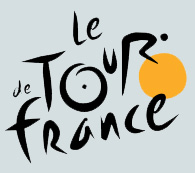 noted
in the newspaper that Lance Armstrong had just won the
Tour de France that
we had been dodging for the past week. I was dressed for running so at
1:00 PM, I started my run back to Cathedral St-Jean and was almost hit by a car.
This was the most harrowing experience with a car I have ever had in all these
many
years of running in Europe. As I ran across this busy street, a car
speeded up as if he was trying to run me down and as I ran like crazy my right leg felt
the car just miss me. It was as if he was purposely trying to hit me.
It really scared the hell out of me and did make me more wary of French drivers.
noted
in the newspaper that Lance Armstrong had just won the
Tour de France that
we had been dodging for the past week. I was dressed for running so at
1:00 PM, I started my run back to Cathedral St-Jean and was almost hit by a car.
This was the most harrowing experience with a car I have ever had in all these
many
years of running in Europe. As I ran across this busy street, a car
speeded up as if he was trying to run me down and as I ran like crazy my right leg felt
the car just miss me. It was as if he was purposely trying to hit me.
It really scared the hell out of me and did make me more wary of French drivers.
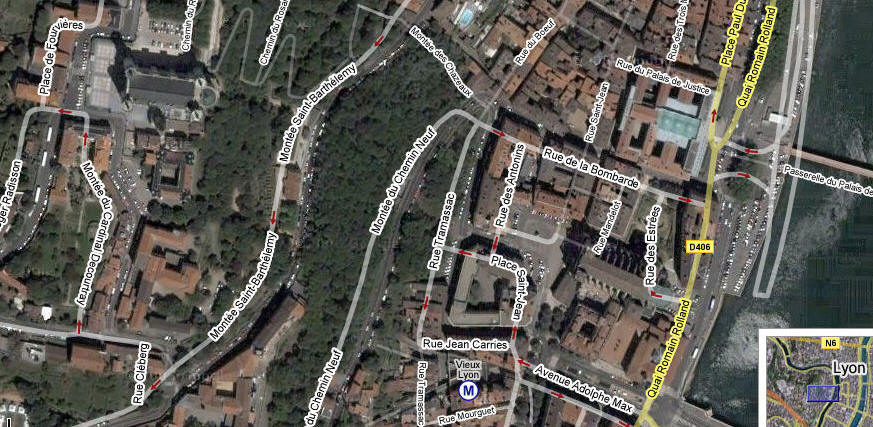
I finished my run and at 1:40 and got to the Funiculaire I was looking for to get up the Fourvi�re hill (tower above right.) They used to have five of these trams but now there are only two. Here are stock photos of the funicular.
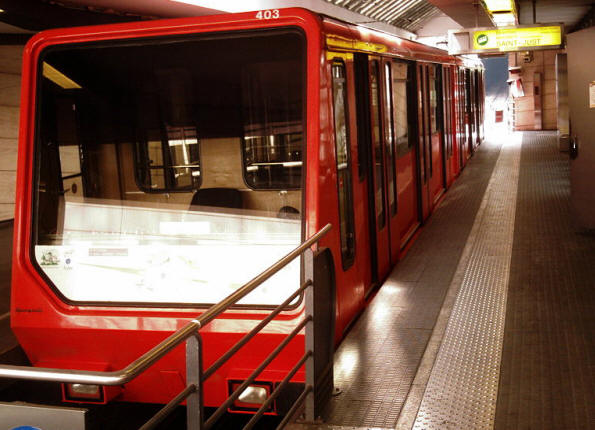
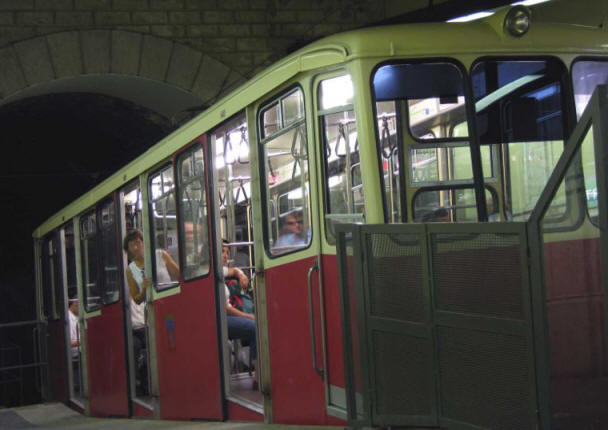
This one is the third line opened in 1878 linking Saint-Jean to Saint-Just with an intermediate station at Minimes. The line was converted to a rack railway in 1901 and then back to a funicular in 1958; it was remodeled in 1986. It takes you to a height of 299 ft (91.2 m) and the length of the trip is a half a mile (791 m) and takes 3.3 minutes. I needed to get off at the Minimes stop.
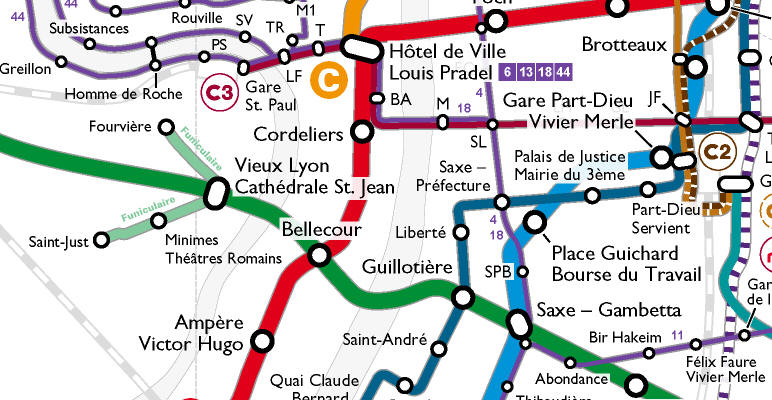
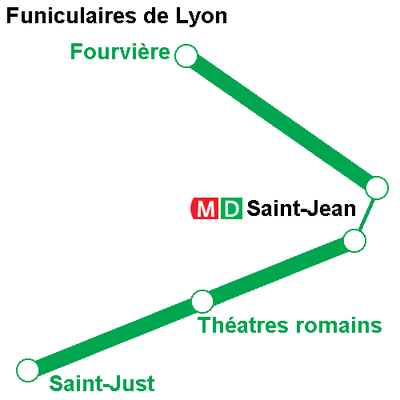
Here is my view heading up the track.
I got off at
1:50 and then had to walk back downhill to get to the Thermes Romains that is
what I came up here for. I got their in ten minutes and then first visited Th��tres Romains.
The Grand Th��tre was built in 15 BC
(the oldest in France) and holds 30,000 people. I also saw the smaller one
called the Od�on but I missed the Amphith��tre des Trois Gaulles (Theater of the
Three Gauls) which was built 29 years later in built 19AD. Here they also
have the Mus�e de la Civilisation Gallo-Romaine [![]() +33-04-72-38-8190.]
+33-04-72-38-8190.]
%20awe.jpg)
When I was done, I decided to walk all the way down the hill back to the city. Here are some of the shots I took on my way down.
%20ae.jpg)
Just before I got to the flat land, I came across this nice waterfall. There is a shot of Cathedral St-Jean.
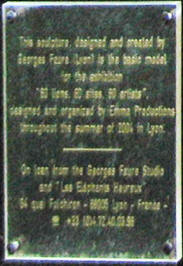
I came across this large sculpture of a lion. The plaque on the front states:
"This sculpture, designed and created by Georges Faure (Lyon) is the basic model for the exhibition "60 lions, 60 sites, 60 artists" designed and organized by Emma Productions throughout the summer of 2004 in Lyon. On loan from the Georges Faure Studio and "Les Elephents Haureux, 34 quai Fulchiron. Lyon +33-47-240-0396."
Now I know where I have seen it before. Remember the photos I took in many areas of Lyon where there were these plastic lions all painted differently in a variety of colors. This was the original sculpture for all of them.
By 2:30 I was walking down hill toward Bellecour, the big plaza (below.)
%20ae.jpg)
At 2:45, I was attempting to cross a busy street (below left) around the plaza. I had been walking with my video camcorder in one hand and a can of soda in the other and decided to go to the bookstore across the street. I didn't notice that this is not a place to cross since there was a fence on the other side. While walking across, I noticed the traffic was coming faster than I expected and I broke into a run to beat it.
As I was running my right foot slammed into this cement strip lane divider (above) which I did not see. I was starting to fall but saw the cars coming rapidly at me and I forced myself to fall forward into the fence. I slammed forcibly into the green iron fence which crushed my soda can and injured the video camera; the Memory stick flew out of it. The ball of my right foot hurt really badly and it was throbbing; I wondered if I had broken a bone in my foot.
After standing and recovering for a while, I hobbled my way over to the garden park and met Marcia. I then went over to the Sofitel hotel at 3:30 and found their lobby bathroom to change my clothes (Marcia had brought them from the car.) She went to a pharmacy and bought some cold packs so I could apply them to my foot on the drive.
[When I got home, I asked Dr. Goldberg to take X-rays of my right foot to see if I had sustained a fracture that day. Below are the X-rays which showed no fracture; it must have been a severe sprain. Still have never broken a bone.]
At
4:00 PM, Marcia
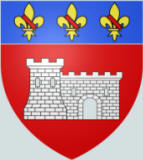 drove
the 22 miles north to the town of
Villefranche-sur-Sa�ne.
drove
the 22 miles north to the town of
Villefranche-sur-Sa�ne. The inhabitants of the town are called Caladois. It has a land area of
3.66 mi2 (9.48 Km2,) a population of 34,626 and a
population density 9,460/mi2 (3,653/Km2.)
The inhabitants of the town are called Caladois. It has a land area of
3.66 mi2 (9.48 Km2,) a population of 34,626 and a
population density 9,460/mi2 (3,653/Km2.)
The town was founded in 1212 by Guichard IV, count of Beaujeu, and in the 14th Century it became the capital of the Beaujolais province. It endured three sieges during the 15th and 16th Centuries. The town walls were taken down early in the 19th Century. Villefranche sits in the center of the famous Beaujolais wine region (left) which is why we are stopping here. We are not going to do a complete wine tour (center) of the region but want to visit at least one. To get this BEAUJOLAIS wine tour interactive map (right) click HERE and HERE.
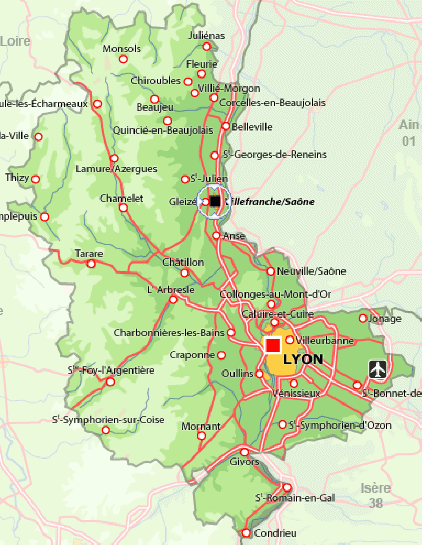
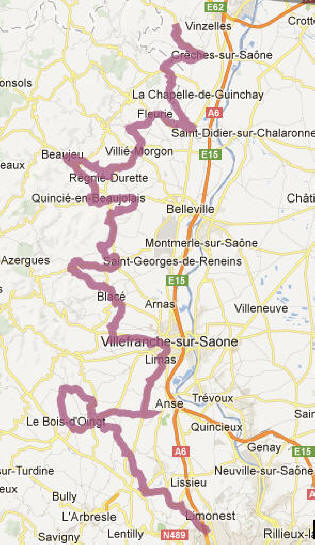
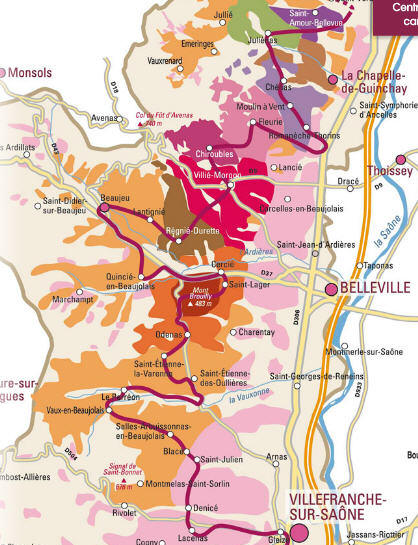
Here are two aerial shots of the city by photographer Christian Garcia of La Soci�t� Entre Ciel Terre et Mer (Between Heaven Earth and Sea Company) at ECTM.fr.
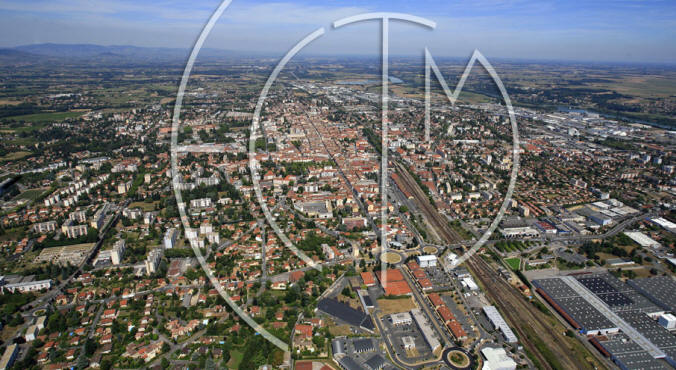
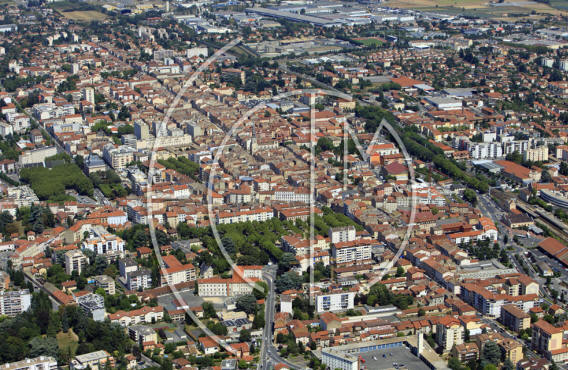
At
4:30 we arrived to take a tour of the winery we chose just outside town called
winery Ch�teau de Vaurenard Beaujolais
[Rue de Chateau, Gleiz�, ![]() +33-47-468-2165,
contact@Ch�teaudeVaurenard.com.]
+33-47-468-2165,
contact@Ch�teaudeVaurenard.com.]
As you can see, their building has a chapel attached. I decided to go over and take a look at it.
We then walked around and finally found the welcome "Caves Ouvertes" sign meaning the tour is open.
We were greeted by the owner and cellar master, Ghislain de Longevialle (below left) who took us on a tour of the wine cellars.
Ghislain then took us to the wine tasting room which was very nice.
He then showed us a list of the available wines they produce that we could taste.
The prices were reasonable, ranging from �5 to �8 per bottle; multiples produce savings.
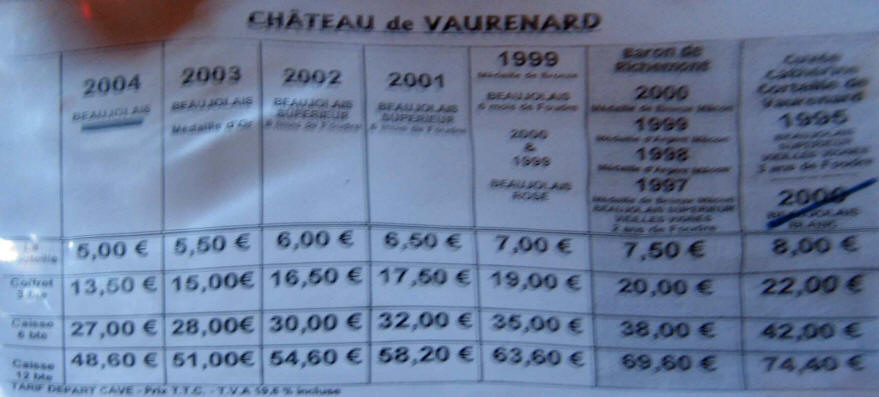
We first tried both the 1999 and 2000 Baron de Richemont Bejolais Sup�rieur which were very nice.
%20e.jpg)
We also tried a few others. I then walked around and looked at all the trophies they had won.
%20e.jpg)
They had this old map of the wine region on the wall. We decided to buy a bottle each of the 1997, 1998, and 2000 vintages to take with us.
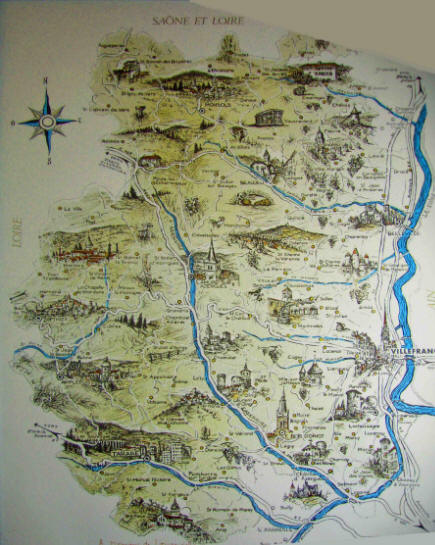
Marcia took a number of photos here. Below is what she took ...
... including catching one of me not posing.
%20e.jpg)
We then walked over and saw the bottling process in action. This is how they do it on a small scale.
%20e.jpg)
%20e.jpg)
We finally left and I went by the chapel and then outside to see the gardens and vineyards.
%20ae.jpg)
%20a2e.jpg)
This why you
come to France. We got back in the car and at
5:45, Marcia drove the 35 miles northeastward to the town of
Bourg-en-Bresse
(coat
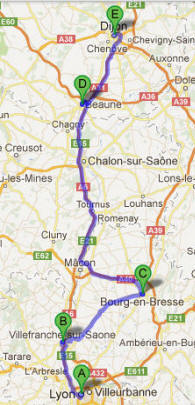 of
arms right) which is
of
arms right) which is
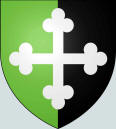 located
(C) at the western base of the Jura mountains, on the left bank of the Reyssouze
River, a tributary of the Sa�ne. The town has a land area of 9.21 mi2
(23.86 Km2,) a population of 40,203 and a population density of
4,360/mi2 (1,685/Km2.) The inhabitants of
Bourg-en-Bresse are known as Burgiens.
located
(C) at the western base of the Jura mountains, on the left bank of the Reyssouze
River, a tributary of the Sa�ne. The town has a land area of 9.21 mi2
(23.86 Km2,) a population of 40,203 and a population density of
4,360/mi2 (1,685/Km2.) The inhabitants of
Bourg-en-Bresse are known as Burgiens.
Roman remains were discovered at Bourg, but little is known of its early history. Raised to the rank of a free town in 1250, it was chosen as the chief city of the province of Bresse by the dukes of Savoy at the beginning of the 15th century. In February 1535, after a full-scale French invasion of Savoy, it passed to France, but was restored to Duke Philibert Emmanuel in 1559, when he married Henri II's sister Marguerite. The Duke later built a strong citadel here, which afterwards withstood a six-month siege by the soldiers of Henry IV. The town was finally ceded to France in 1601.
The town is most famous for one thing, their Poulet de Bresse, which is a breed of chicken originating here. The birds are highly valued for their gamey depth of flavor, with fine tender flesh and delicious clean-flowing fat. Roughly 1.2 million are raised annually, but the demand is so high in France that few birds make it out of the country. As a premium product (below right,) they sell at a premium price of around $9.50 (�6.80) per pound. Not KFC chicken.
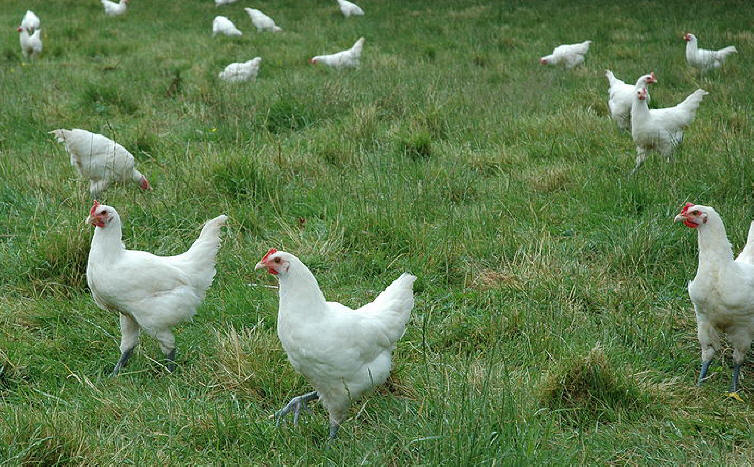
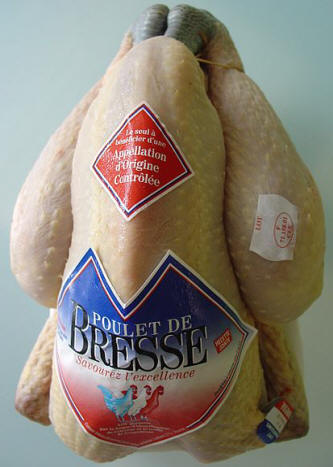
The most typical examples, known as B�ny (above left,) have a distinctive red crop, white feathers and blue feet, making up the colors of the French flag, and an ideal national mascot. Black (Bourg) and grey (Louhans) feather varieties are also common. When butchered, the chickens have a clear reddish-pink tone to the flesh and pronounced yellowish fat. Their bones are surprisingly light for sturdy, free-range birds. Poulet de Bresse are reared to exacting standards by small farms in a small designated area around the city. They have been protected under French and European law (Appellation d�origine contr�l�e) since 1957; the first livestock to be granted such protection.
We arrived in the center of town at 6:40 PM and then attempted to visit the Brou (the Cathedral) but we were too late; it was closed. So Marcia pulled over and I photographed the outside.
This is the Royal Monastery of Brou and is composed of monastic buildings and a church, which were built at the beginning of the 16th Century by Margaret of Austria (1438-1483,) the daughter of the Holy Roman Emperor, Maximilian I and Governor of the Habsburg Netherlands. The complex was designed as a dynastic burial place in the tradition of the Burgundian Champmol, C�teaux Abbey and the French St-Denis. The church was built between 1506 and 1532 in a lavishly elaborate Flamboyant Gothic style, with some classicizing Renaissance aspects. The tall roof is covered in colored, glazed tiles. As you can see today the front is covered with scaffolding so here is a stock photo of the front (below right.)
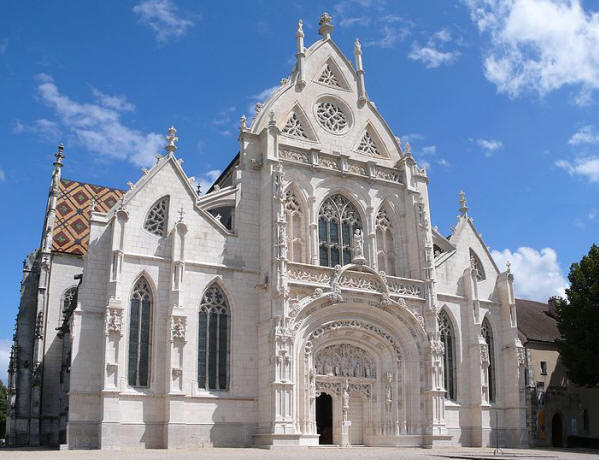
I walked around and got some pictures of the side of the church with its multi-colored tile roof.
%20awe.jpg)
The monastery is the property of the town of Bourg-in-Bresse, which installed the municipal art collection in the buildings in 1922. The museum presents religious statues of the 13th to 17th Centuries on the ground floor, and a collection of paintings of the 16th to the 20th Centuries on the upper floor. Since we can't get inside, here are stock photos of this historic church.
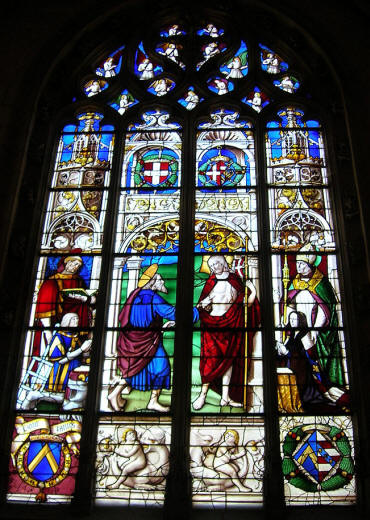
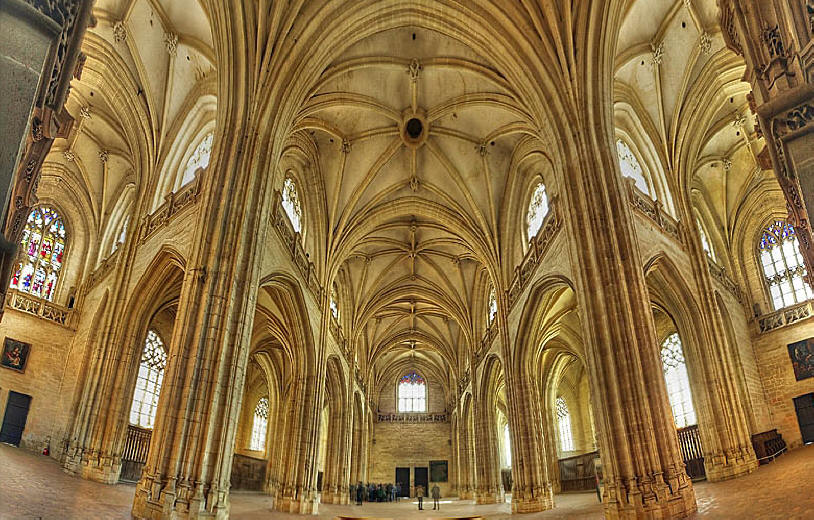
The stalls (below right) are from the 16th Century.
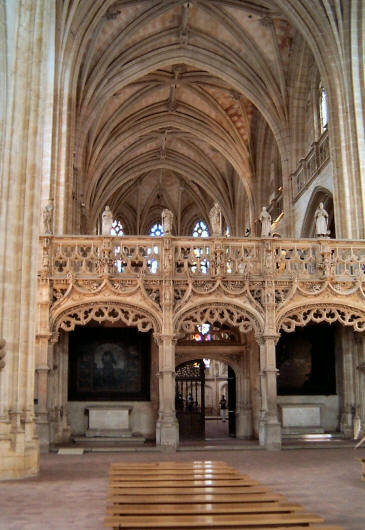
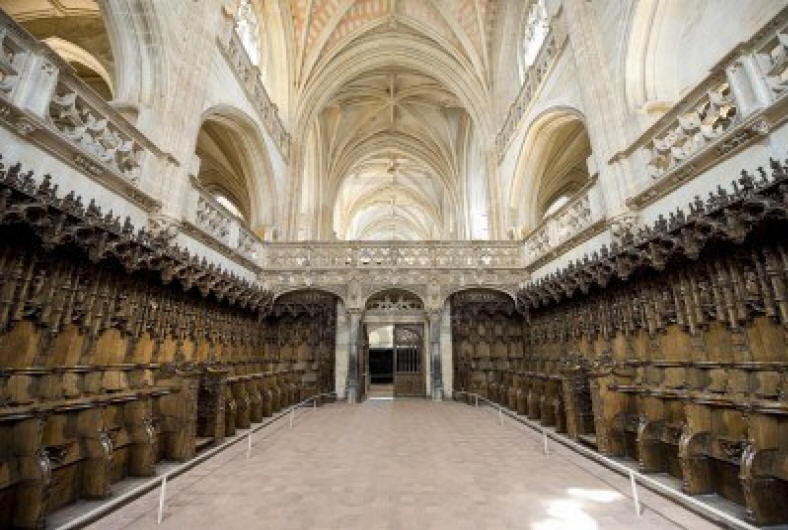
Margaret (below left,) her second husband Philibert II, Duke of Savoy and his mother, Margaret of Bourbon, are all buried in tombs within the church. They avoided the destruction that most royal tombs in France have suffered.
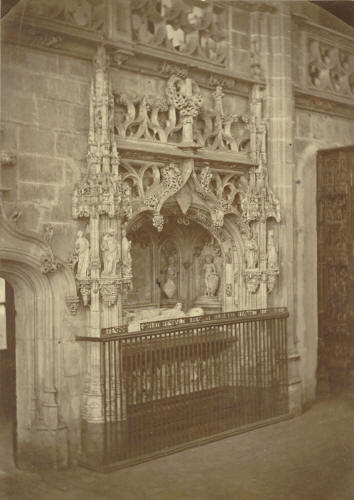
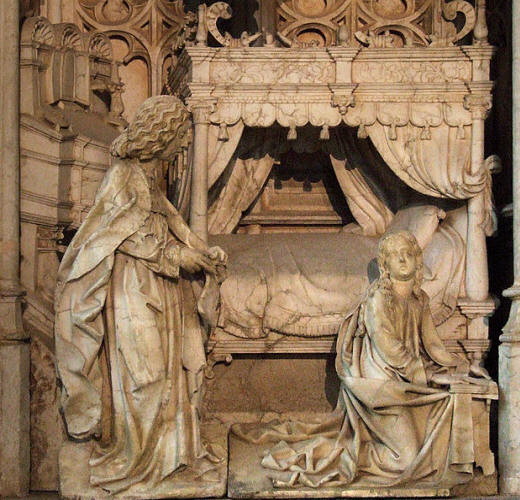
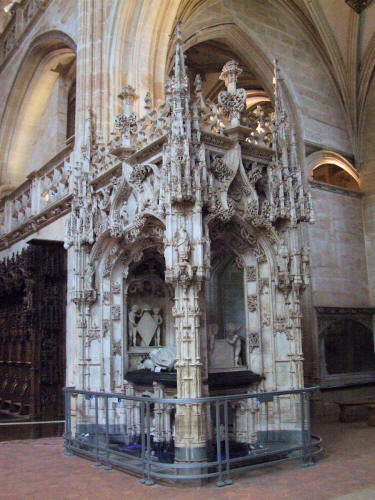
It is now
7:00 PM and we have to get going so Marcia drove the 75 miles
west and then north to the town of Beaune. On our way, we passed through
the town of
Chalon-sur-Sa�ne (coat of arms right) which happens to be the birthplace of
photography. In 1822, Joseph Nic�phore
Ni�pce (below left)
created the the first successful permanent photograph from nature which he
called Heliography. Below are copies of the first and second photos ever
taken. In the center is the "View from the Window at Le Gras"
and the very first, which he created with a camera obscura focused onto a 7.9 in
� 9.8 in (20 cm � 25 cm) pewter plate coated with bitumen of Judea, a mixture
similar to asphalt. The bitumen mixture hardened when exposed to the
light, while the unexposed portions remained water soluble and could be washed
away with a mixture of oil of lavender and white petroleum. As a result of
the 8-hour exposure, sunlight illuminates the buildings on both sides.
miles
west and then north to the town of Beaune. On our way, we passed through
the town of
Chalon-sur-Sa�ne (coat of arms right) which happens to be the birthplace of
photography. In 1822, Joseph Nic�phore
Ni�pce (below left)
created the the first successful permanent photograph from nature which he
called Heliography. Below are copies of the first and second photos ever
taken. In the center is the "View from the Window at Le Gras"
and the very first, which he created with a camera obscura focused onto a 7.9 in
� 9.8 in (20 cm � 25 cm) pewter plate coated with bitumen of Judea, a mixture
similar to asphalt. The bitumen mixture hardened when exposed to the
light, while the unexposed portions remained water soluble and could be washed
away with a mixture of oil of lavender and white petroleum. As a result of
the 8-hour exposure, sunlight illuminates the buildings on both sides.
Amazing; this guy was a genius. Later he and his brother Claude, invented the first combustion engine they called the Pyr�olophore (below center.) Their Pyr�olophore was the first use of an internal combustion engine in a boat in 1807. I'm sure very few people know of this town or Mr. Ni�pce. The town has a statue honoring him.
At
7:15 we had a little freeway screw-up which added
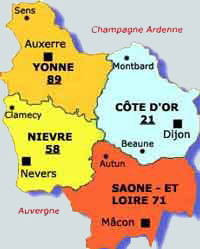
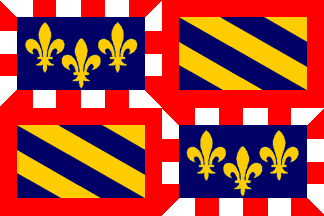 another 12 miles
to the trip.
Somewhere along the way we leave the Rh�ne-Alpes and enter our third region, Bourgogne
(map left & below, flag right.) Bourgogne has four divisions;
another 12 miles
to the trip.
Somewhere along the way we leave the Rh�ne-Alpes and enter our third region, Bourgogne
(map left & below, flag right.) Bourgogne has four divisions;
1) Yonne (orange) with Auxerre as its capital,
2) Nievre (yellow) with Nevers as its capital,
3) Saone-Et Loire (red) with M�con as its capital and
4) C�te D'Or (blue) where sits the capital, Dijon, which is also the capital of Burgundy.
Below left is a map of the major political divisions of France and on the right is one of the wine region designations for orientation. We have gone from the Prov�nce region to the Rh�ne region and now the Burgundy region.
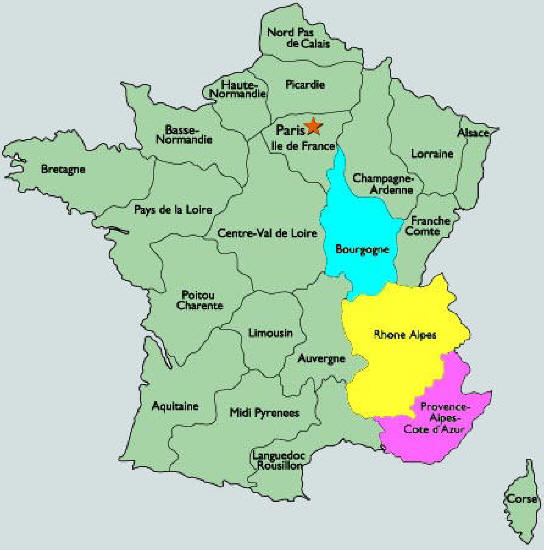
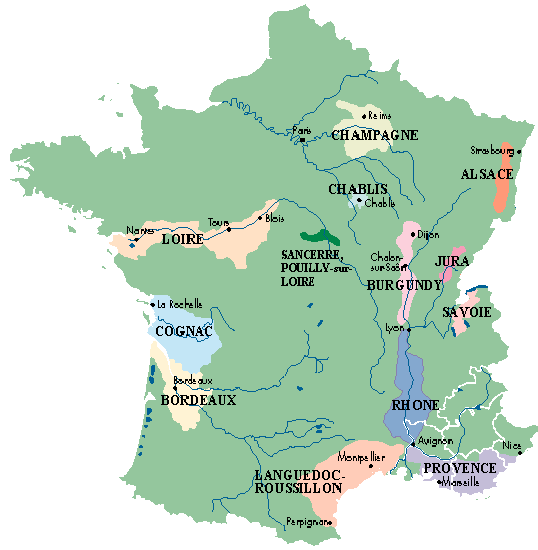
We finally arrived in
Beaune
(pronounced "bone") (coat of arms right)
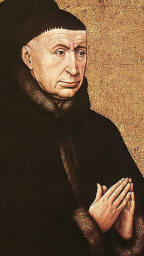 at
8:30
PM. It is the wine capital of
Burgundy
at
8:30
PM. It is the wine capital of
Burgundy
 and
is considered the "Capital of
Burgundy wines." The annual wine auction held here at the
Hospices de Beaune is the primary wine auction in all of France.
The Hospices is also called H�tel-Dieu de Beaune and is a former charitable
almshouse founded in 1443 by
Nicolas Rolin (left,) chancellor of Burgundy, as a hospital for the poor and
needy. He was exceedingly wealthy and felt very sorry for the poverty of
the peasantry who were severely affected by the Thirty Years War.
and
is considered the "Capital of
Burgundy wines." The annual wine auction held here at the
Hospices de Beaune is the primary wine auction in all of France.
The Hospices is also called H�tel-Dieu de Beaune and is a former charitable
almshouse founded in 1443 by
Nicolas Rolin (left,) chancellor of Burgundy, as a hospital for the poor and
needy. He was exceedingly wealthy and felt very sorry for the poverty of
the peasantry who were severely affected by the Thirty Years War.
It is an ancient and historic town on a plain by the hills of the C�te d'Or, with features remaining from the pre-Roman and Roman eras, through the medieval and renaissance periods and up to modern times. Beaune is a walled city, with about half of the battlements, ramparts, and the moat, having survived and being in good condition (below.)
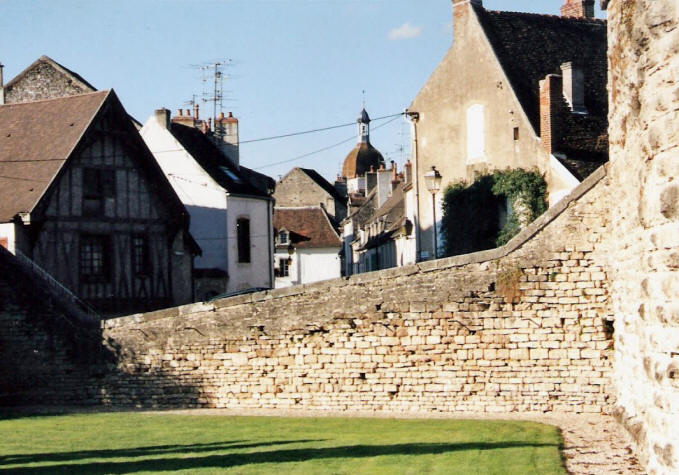
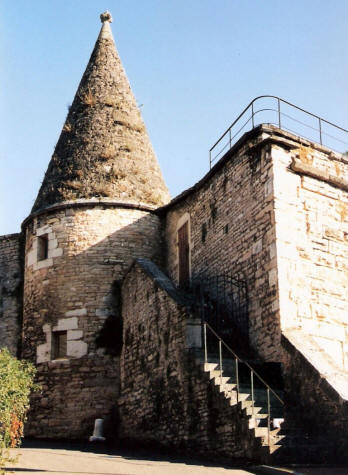
The central "old town" is extensive. Beaune has a land area of 12.1 mi2 (31.3 Km2,) a population of 222,218 with a population density of 1,800/mi2 (710/Km2.) Historically, Beaune is intimately connected with the Dukes of Burgundy. Landmarks in Beaune include the Halles, the Hospices, the Beffroi, and Notre Dame (see maps below.) There is a comprehensive traditional shopping area clustered around the central square with a focus on gourmet food, fashion and of course, wine. Large supermarkets and business parks are situated on the outskirts of town.
The blue banners hanging in town are announcing an International Baroque Opera Festival. Let's take a little tour. Here are maps of the old town.
%20e.jpg)
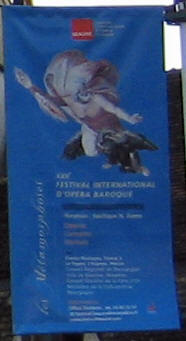
First we'll visit the Beffroi (the clock tower) (see in map above, stock photos below.)
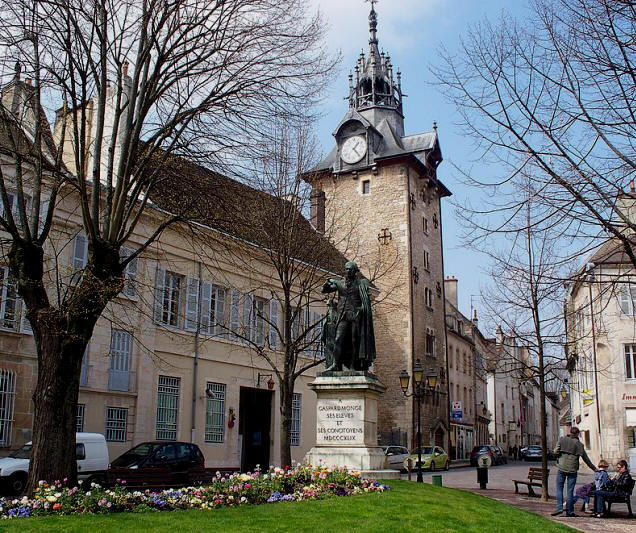
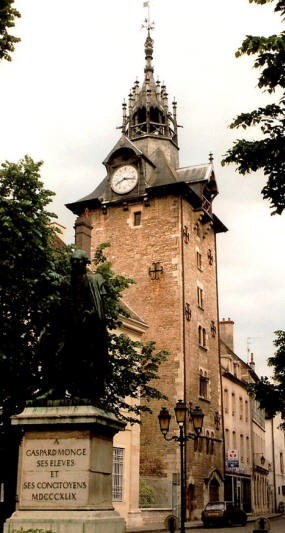
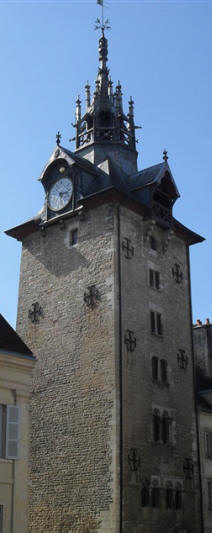
Note the statue in the little park nearby. It is of a native son,
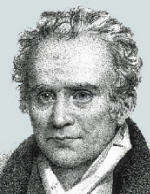 Gaspard
(Caspar) Monge (1746-1818,) Comte de P�luse. He was a mathematician
and the inventor of
descriptive geometry, the mathematical basis on which technical drawing is
based. Monge's protocols allow an imaginary object to be drawn in such a
way that it may be modeled in 3-D. During the French Revolution he served
as the Minister of the Marine and was involved in the reform of the French
educational system, helping to found the �cole Polytechnique. Monge
(right) died in Paris on July 28, 1818, and he was buried in a mausoleum in the
famous Le P�re Lachaise Cemetery in Paris. His remains were later
transferred to the Panth�on in Paris where all the important French are buried.
This statue was erected in 1849. His name is one of the 72 names inscribed
on the base of the Eiffel Tower.
Gaspard
(Caspar) Monge (1746-1818,) Comte de P�luse. He was a mathematician
and the inventor of
descriptive geometry, the mathematical basis on which technical drawing is
based. Monge's protocols allow an imaginary object to be drawn in such a
way that it may be modeled in 3-D. During the French Revolution he served
as the Minister of the Marine and was involved in the reform of the French
educational system, helping to found the �cole Polytechnique. Monge
(right) died in Paris on July 28, 1818, and he was buried in a mausoleum in the
famous Le P�re Lachaise Cemetery in Paris. His remains were later
transferred to the Panth�on in Paris where all the important French are buried.
This statue was erected in 1849. His name is one of the 72 names inscribed
on the base of the Eiffel Tower.
Our next stop is the famous Hospices mentioned earlier. Since we never found this side of the building and it was too late to get in, here are stock photos of it.
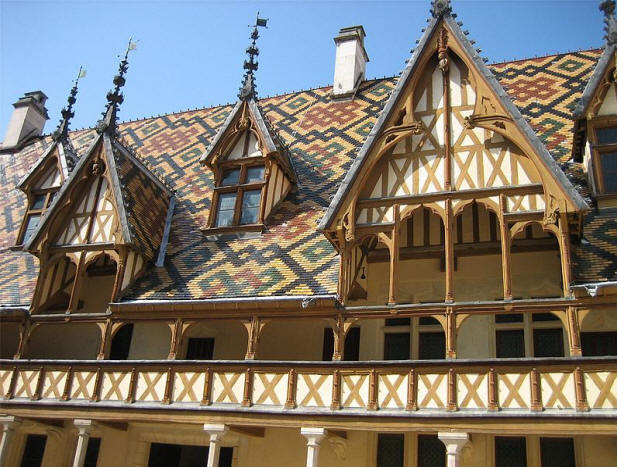
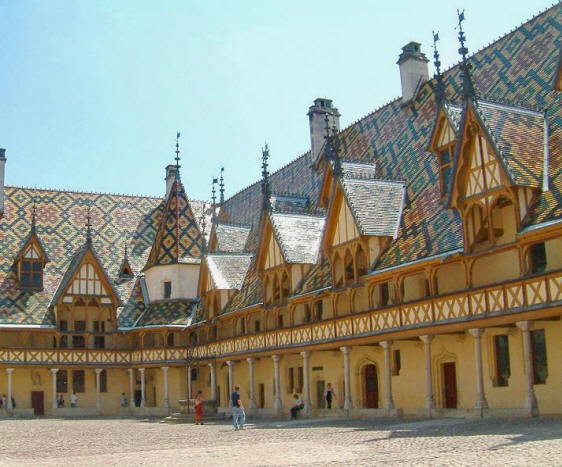
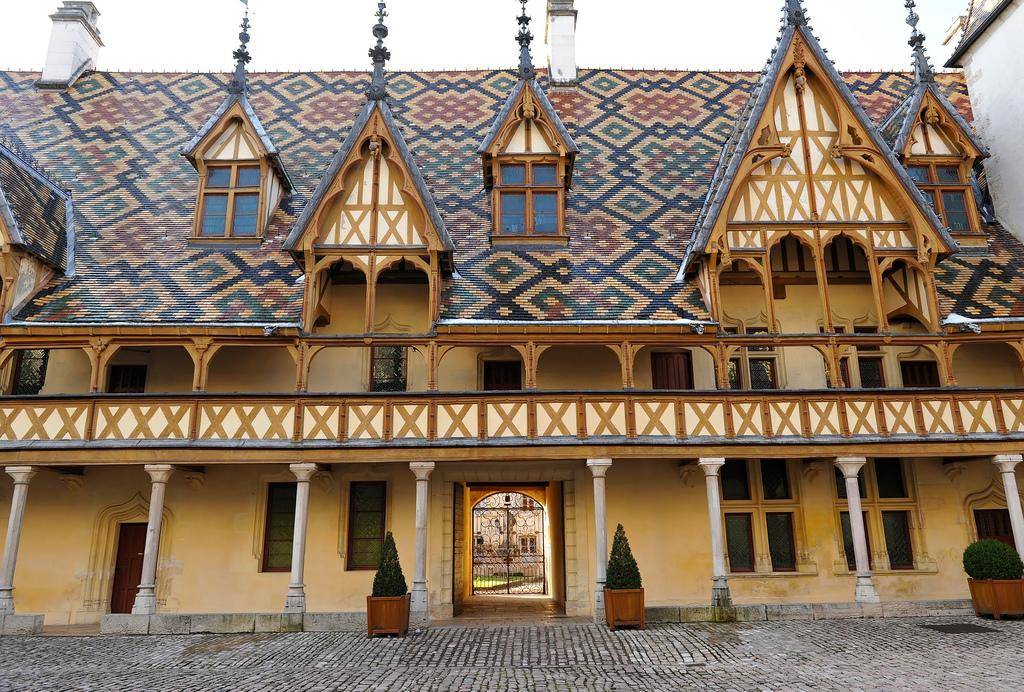
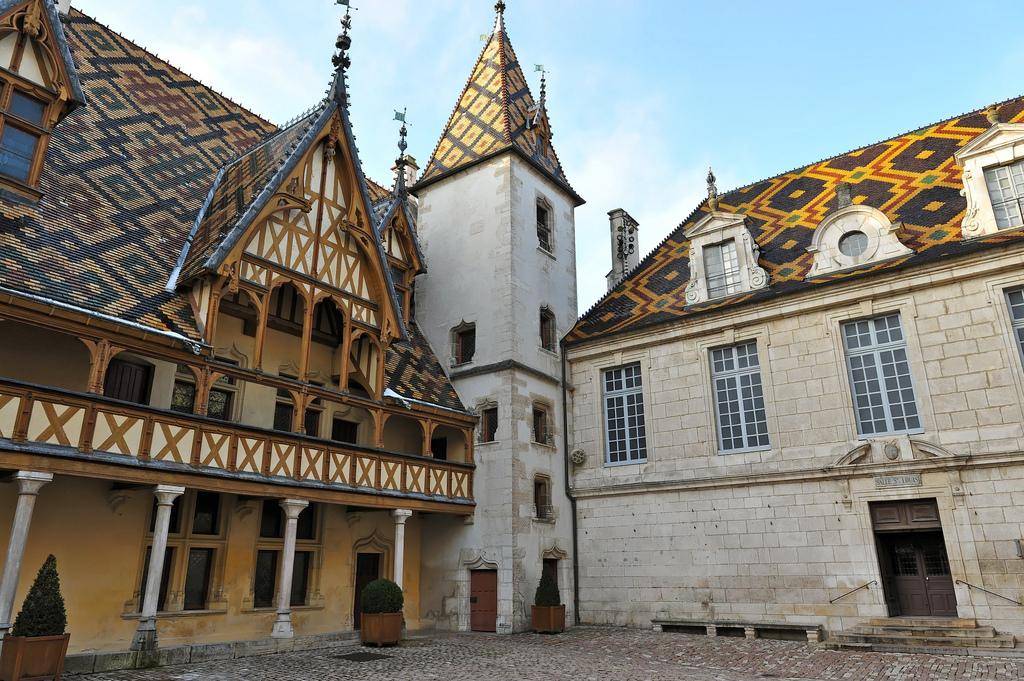
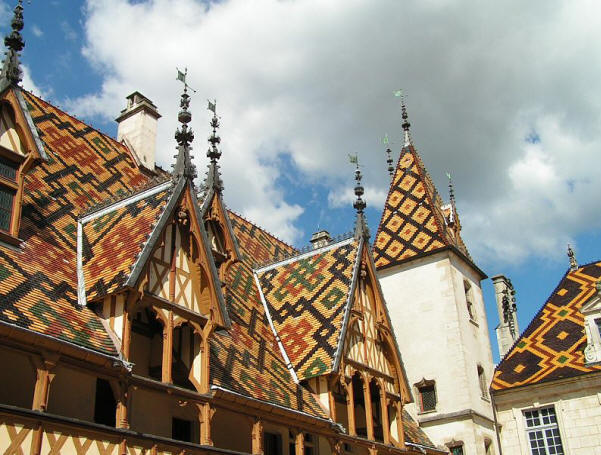
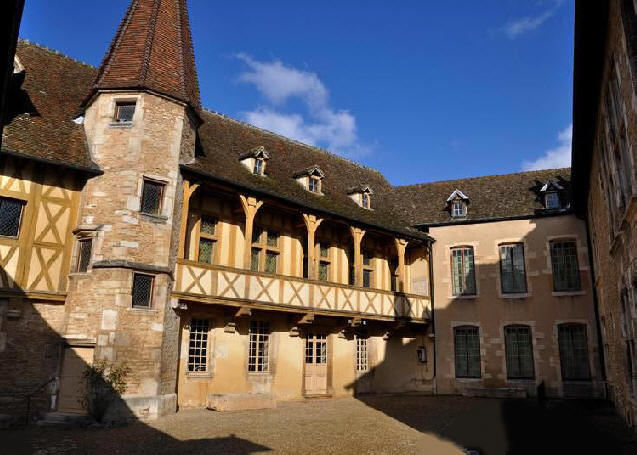
Now we can take a tour through the museum inside.
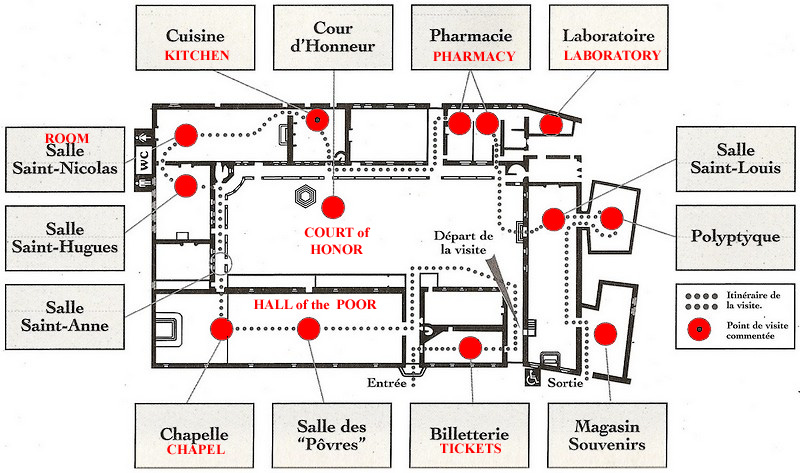
The first room displays the Polyptyque (below left.) Then there is the La Grande salle or the "Chambre des P�vres" with the hospital beds (below right and below.)
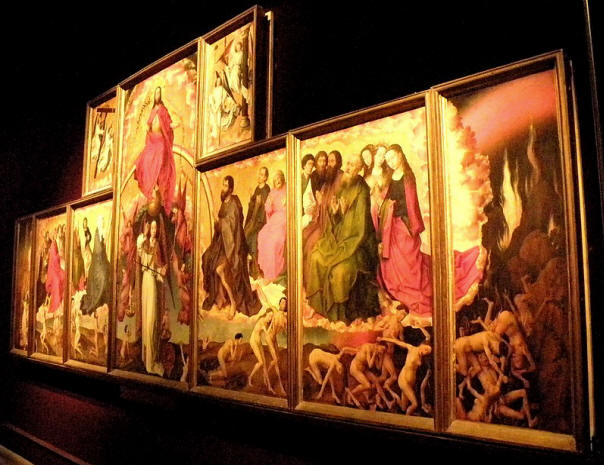
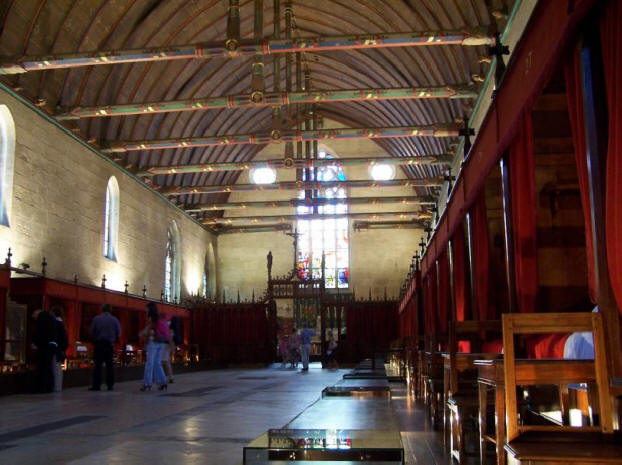
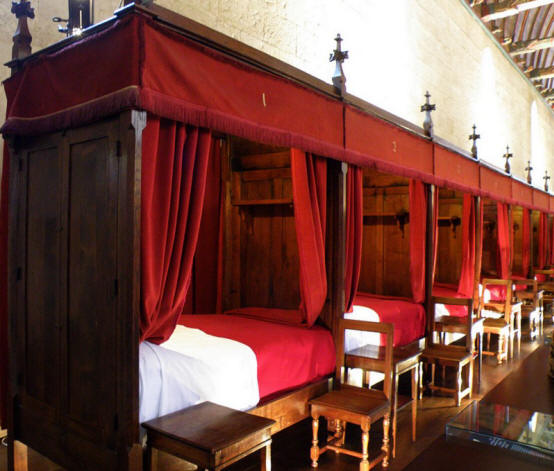
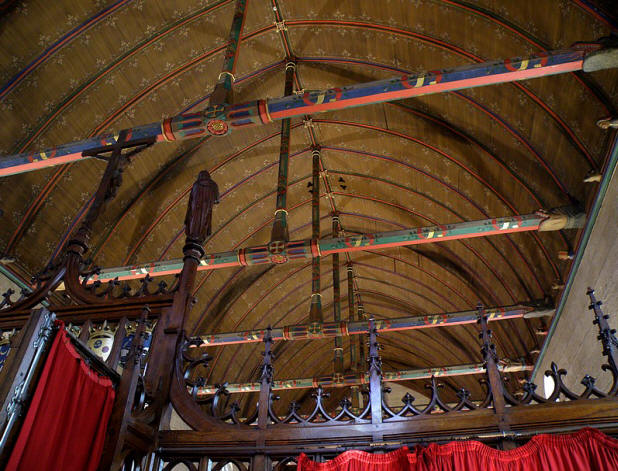
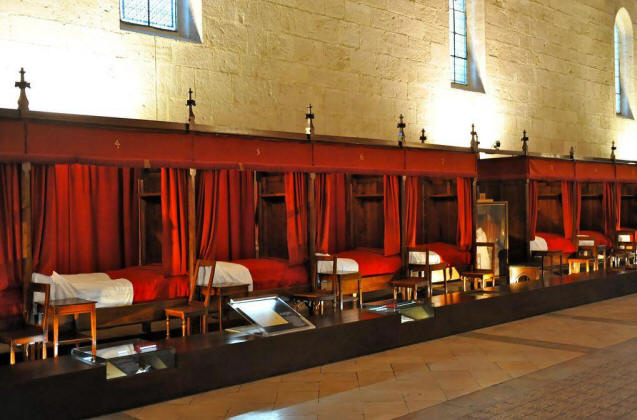
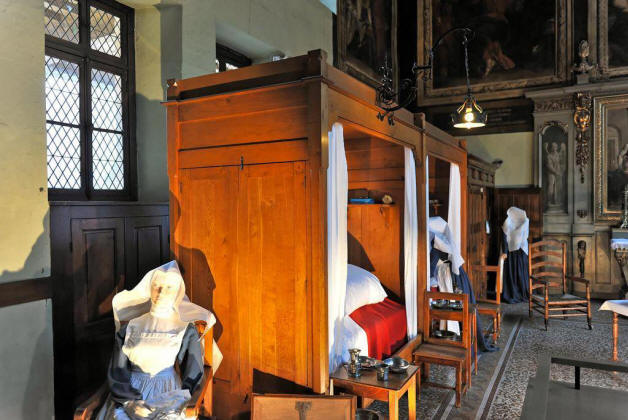
Then there is the Pharmacy and the Kitchen.
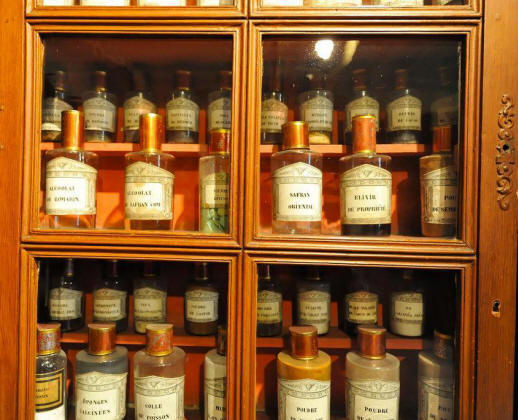
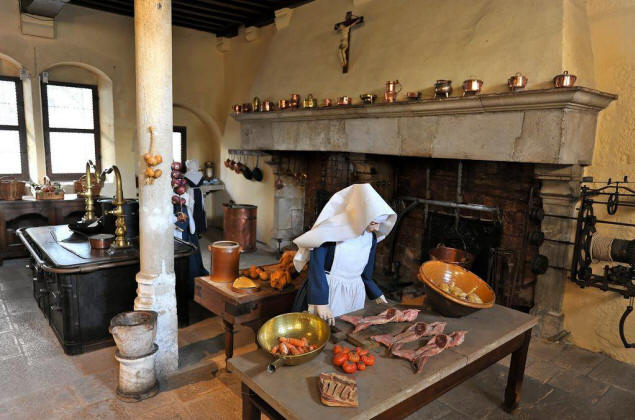
The Laboratory displays ancient medical instruments.
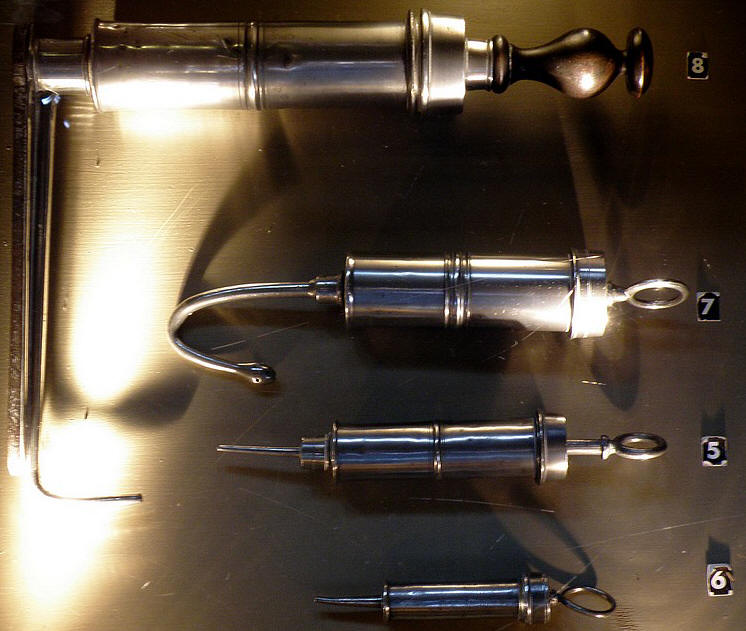
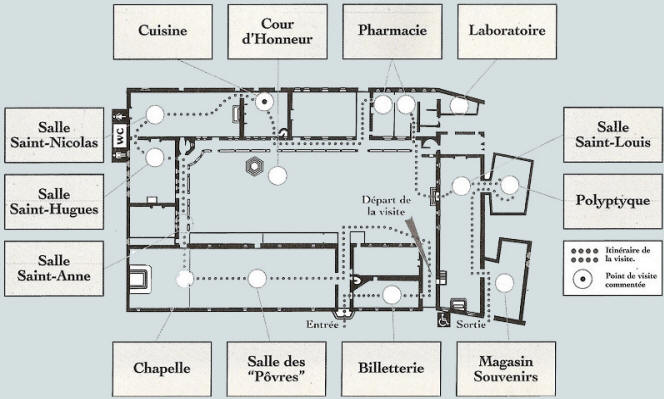
Below left is the Chapelle with its altar and on the right is the Salle Saint-Hugues.
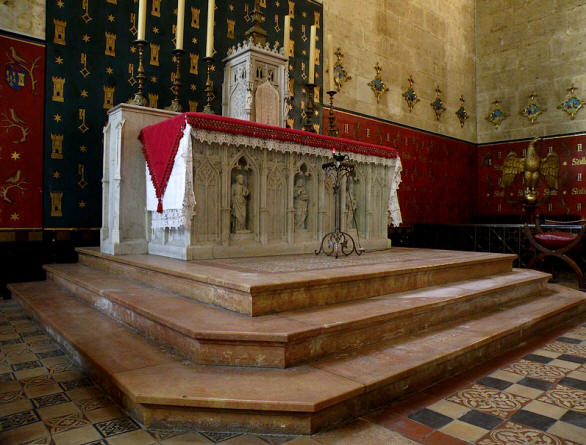

There is this four-panel art piece which displays the benefactors of this place who built it, Nicolas Rolin (left) and his wife (on the right.)
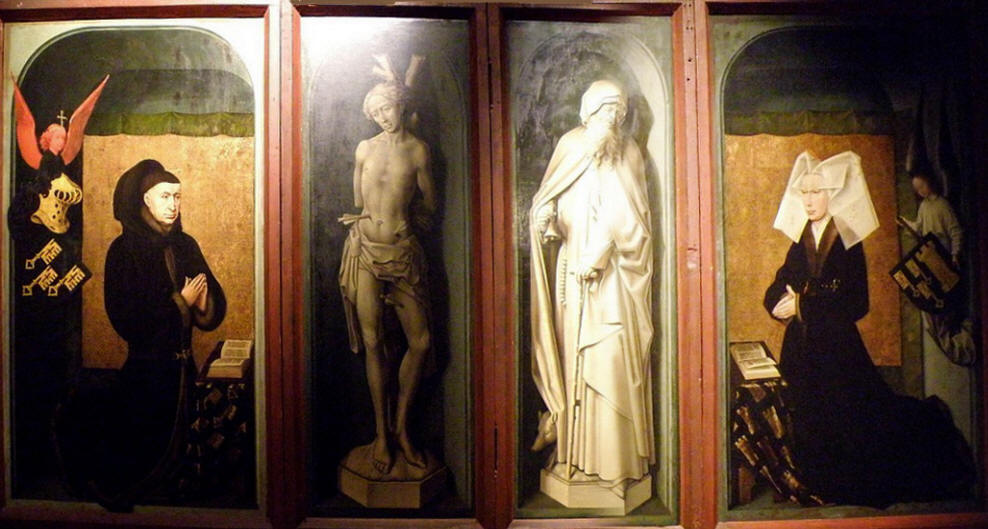
The last of the tourist attractions here in Beaune is the Collegiate de Notre Dame. Here are some stock photos of it. The front entrance is on the left and the back of the church on the right.
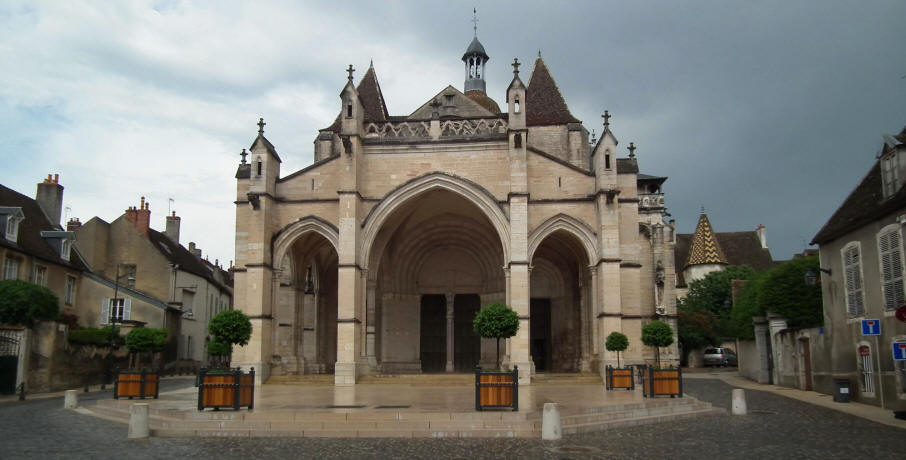
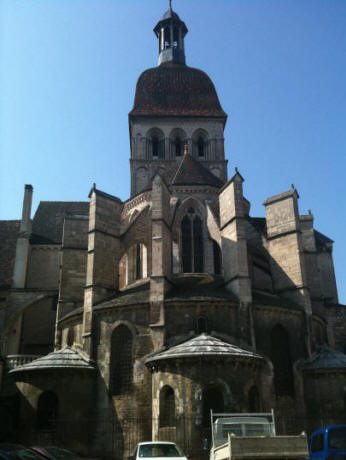
The left two photos are looking toward the altar and the right is looking toward the back of the church ...
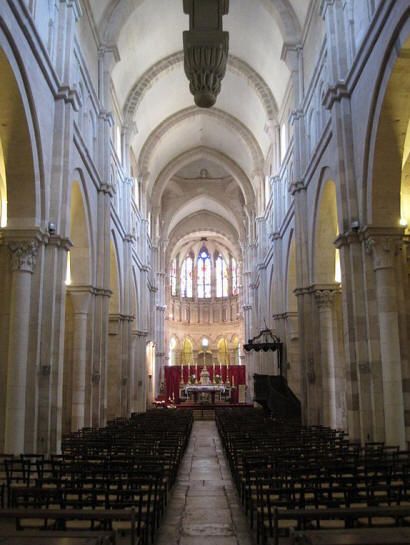
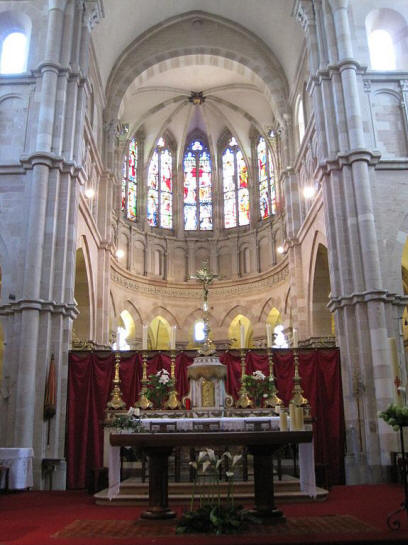
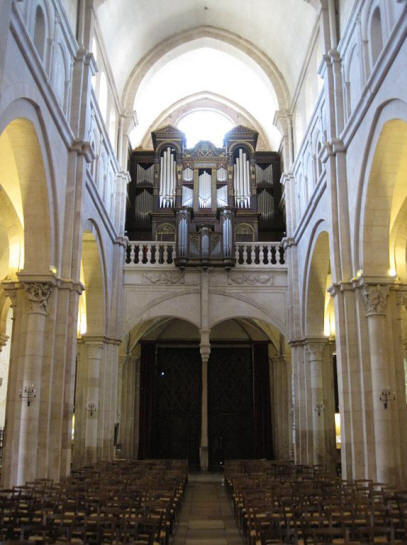
... with its impressive organ.
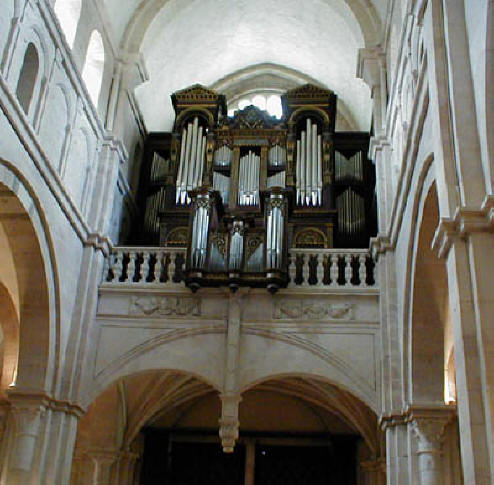
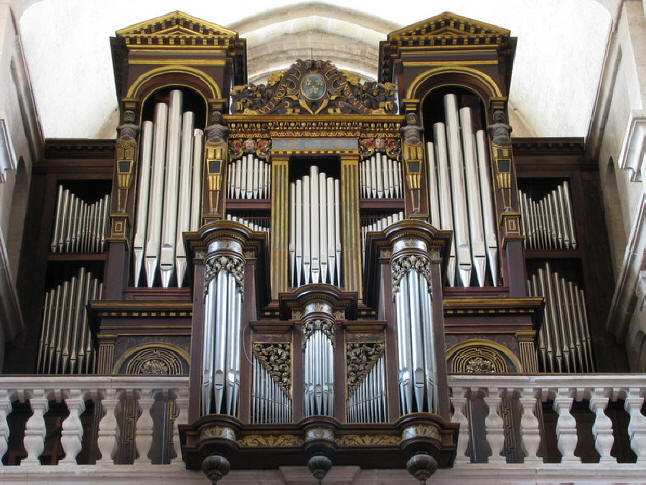
The dome of the church over the apse is accentuated with many stained-glass windows.
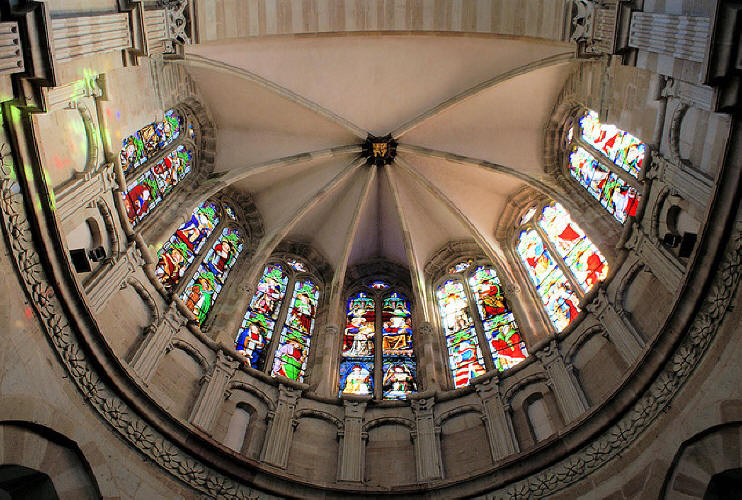
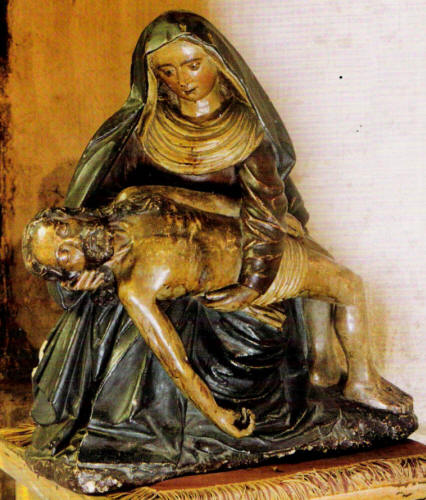
They also have a wood carved Pieta (above right) and a series of beautiful tapestries (below.)
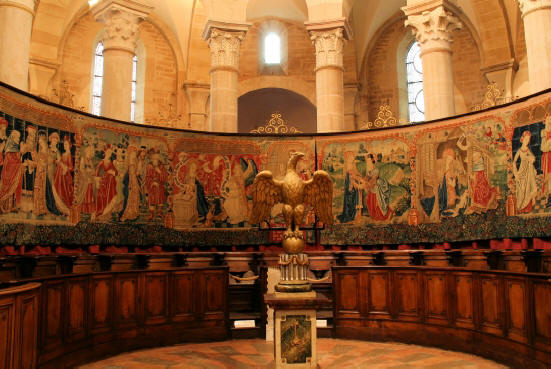
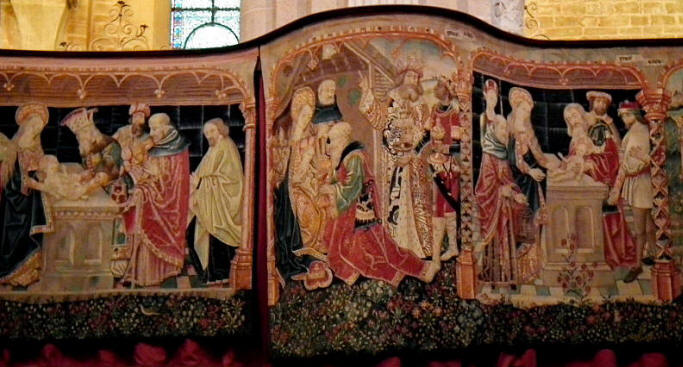
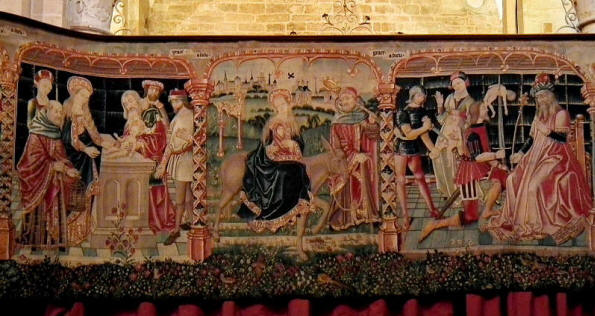
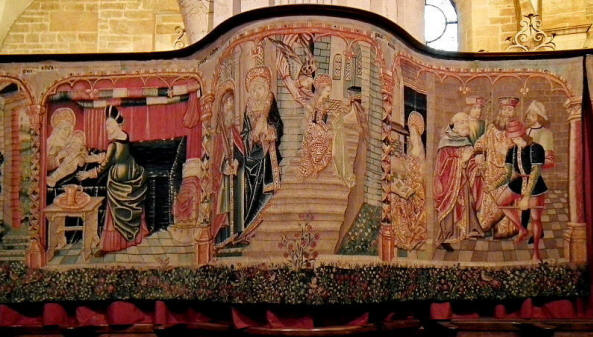
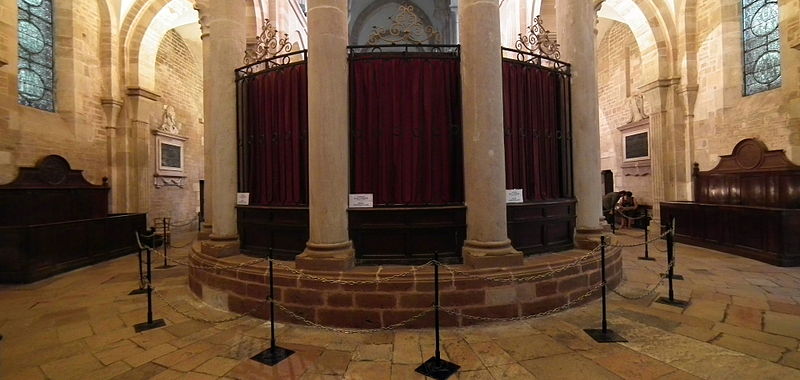
Interesting Aside
Louis Chevrolet (below) (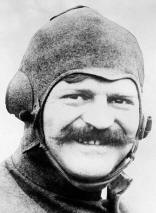
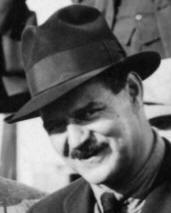 1878�1941)
was a famous race car driver. Chevrolet's family left the Jura,
French-speaking area of Switzerland to live here in Beaune.
1878�1941)
was a famous race car driver. Chevrolet's family left the Jura,
French-speaking area of Switzerland to live here in Beaune.
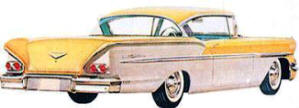 It
was here, as a young man, Louis developed his mechanical skills and interest in
bicycle racing. The family
later emigrated to Montreal in 1900 and then NYC in 1901. He got into
racing cars and was very successful at it. On November 3, 1911 Chevrolet
cofounded the
Chevrolet
Motor Car Company with
William C Durant
(founder of General Motors) (below left;) but now ousted from GM) and investment
It
was here, as a young man, Louis developed his mechanical skills and interest in
bicycle racing. The family
later emigrated to Montreal in 1900 and then NYC in 1901. He got into
racing cars and was very successful at it. On November 3, 1911 Chevrolet
cofounded the
Chevrolet
Motor Car Company with
William C Durant
(founder of General Motors) (below left;) but now ousted from GM) and investment
 partners
William Little and Dr. Edwin R. Campbell (son-in-law of Durant.) The
company was established in Detroit. One story tells the choosing of the
company's logo (right) as a stylized Swiss cross, to honor his parents'
homeland. He died nearly penniless on June 6, 1941 in Detroit. Below
center is the first Chevy ever made, the 1911-4 Model C. To see all the
subsequent models through the years click
HERE. My
favorite was the 1958 Impala (above & below right.)
partners
William Little and Dr. Edwin R. Campbell (son-in-law of Durant.) The
company was established in Detroit. One story tells the choosing of the
company's logo (right) as a stylized Swiss cross, to honor his parents'
homeland. He died nearly penniless on June 6, 1941 in Detroit. Below
center is the first Chevy ever made, the 1911-4 Model C. To see all the
subsequent models through the years click
HERE. My
favorite was the 1958 Impala (above & below right.)
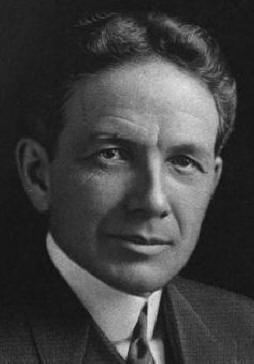
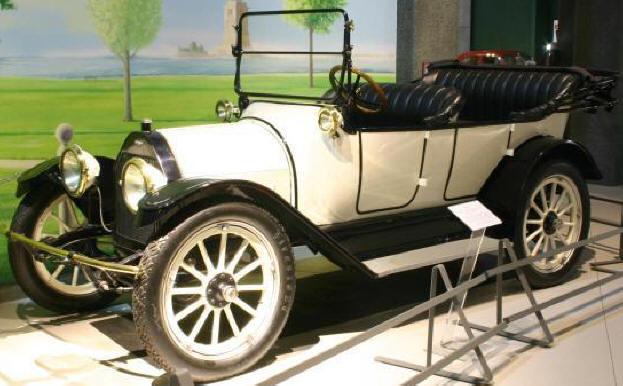
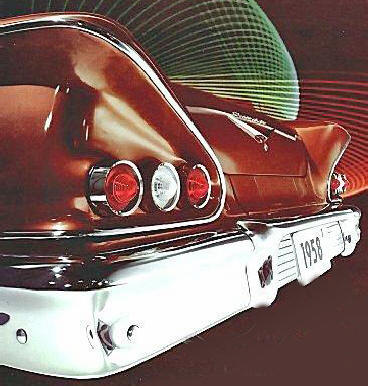
He was so revered, they have a statue memorial for him at the Indianapolis International Speedway.
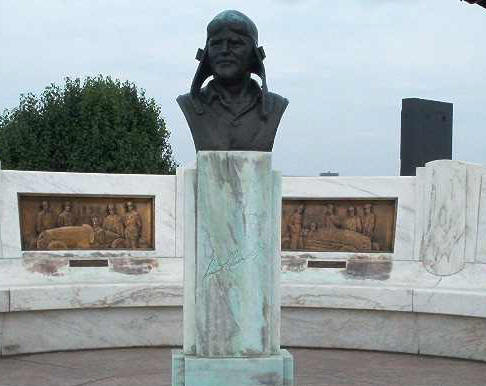
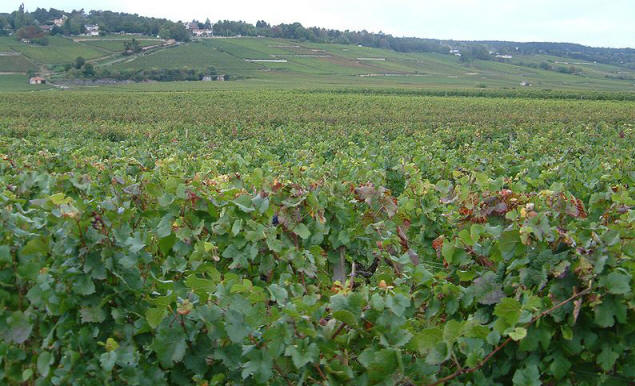
We parked the car and got out to wander around. Below right is a store window full of wood sculptures.
Here are examples of the town.
The place is very cute and well kept up with inviting dining venues.
I did a lot of walking to see as much of it as I could.
At
8:35 I needed a rest and sat down and had a soda at Au Grand Caf� de Lyon [36,
place Carnot,
![]() +33-89-910-3833] (below left) and then walked around the downtown area and came
across this typical wine shop called Moillard.
+33-89-910-3833] (below left) and then walked around the downtown area and came
across this typical wine shop called Moillard.
I took some shots of the wine they have displayed here.
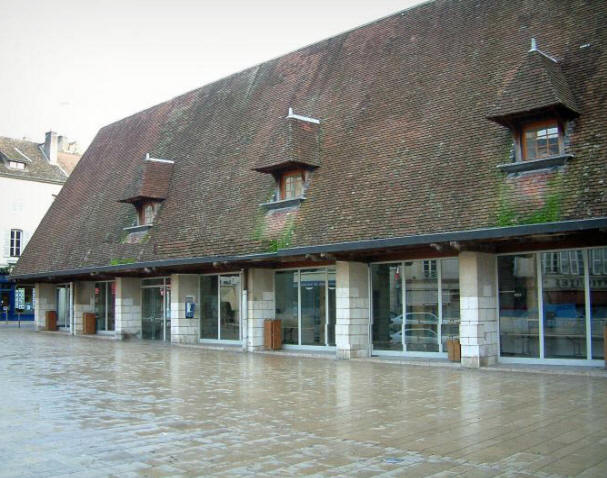
On our way back to the car we passed through the Place des Halles (market square) (stock photo above right) and below you can see the Hospices building exterior (without the pretty tiled roof.) Somehow, we never got to see the front. The disadvantages of not reading tour books through and through as you travel.
We kept walking back to the parking lot and this PhotoStitch wound up including two Marcias.
%20be.jpg)
Marcia loves photographing these Merry-go-Rounds (above left.) Here is what she took of this one.
.jpg)
The map above show where we have traveled (yellow) prior to today and where we
traveled today (red.) We wish we could stay here longer but at
9:10 PM, Marcia drove the remaining 27 miles north to Dijon. So from Lyon
to Villefranche to Bourg-en-Bresse to Beaune to Dijon (below left) made for a
long day even though it was a short drive. We arrived in Dijon at
9:45 and raced to check into the
Sofitel Dijon La Cloche
(below) [14 place Darcy,
![]() +33-38-030-1232, H1202@sofitel.com.]
They gave us room #115.
+33-38-030-1232, H1202@sofitel.com.]
They gave us room #115.

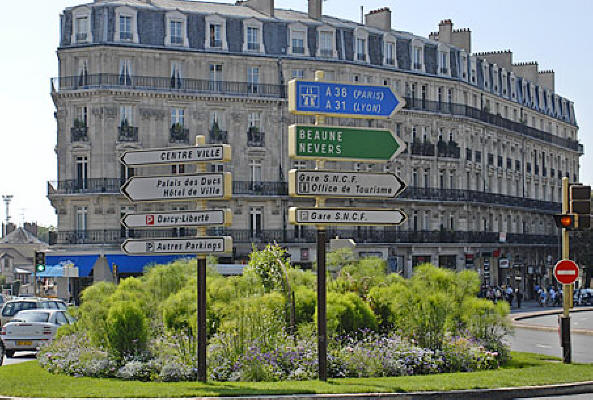
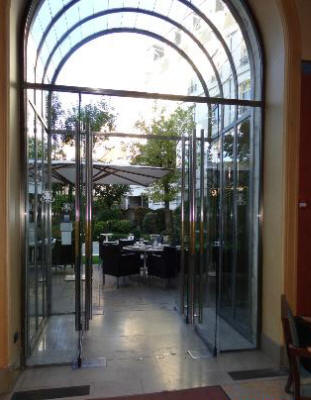
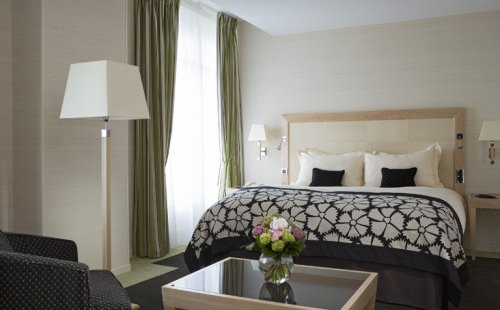
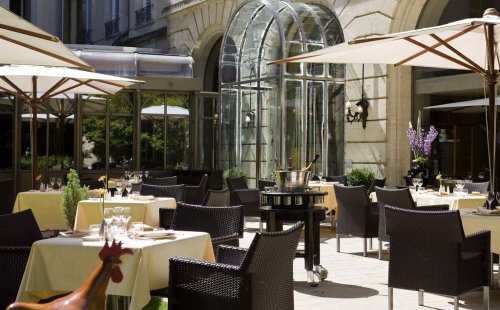
We had no
idea about dinner or whether any places were still serving. To our relief
the girl at the desk recommended a good place to eat dinner this late at night and made dinner reservations for us.
We left our bags with her in the lobby and the bellboy
drove us with our car to restaurant. At
10:00, we arrived for dinner at Au Bon Pantagruel
[Place du March�, 20 rue Quentin,
![]() +33-38-030-6869.] It is located in this central square called the Place du
March�. He then drove our car back to the hotel. That was very nice
service, especially at this late hour. Below left is how Place du March�
looked in 1907 and on the right, how it looks today.
+33-38-030-6869.] It is located in this central square called the Place du
March�. He then drove our car back to the hotel. That was very nice
service, especially at this late hour. Below left is how Place du March�
looked in 1907 and on the right, how it looks today.
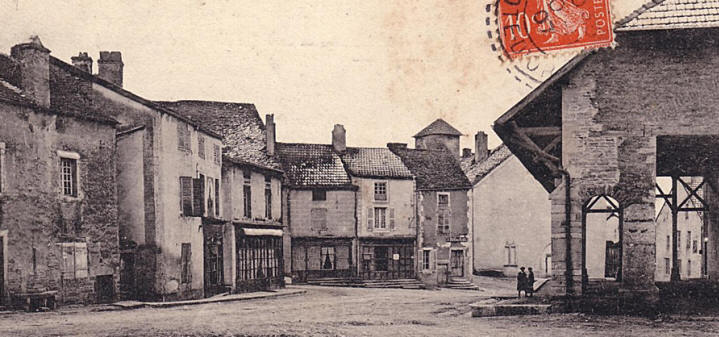
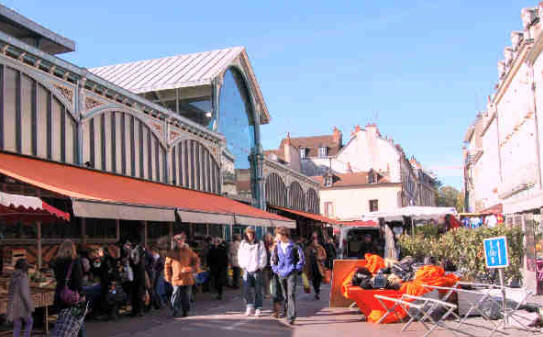
It was a beautiful evening but we decided to take a seat inside.
We ordered a bottle of San Pelligrino and a bottle of local Jaques Kohut Bourgogne blanc (chardonnay.) We always try to drink the local wine. For dinner, I started with their Millefeuille d'Escargots et Cuisses de Grenouilles sauce poulette (Puff pastry over snails and frog legs in a chicken sauce) (below left) and Marcia had Saucisse de Morteau � la Franc-Comtoise (Sausage Morteau a la Franche-Comte with potatoes and salad) (below right.)
%20e.jpg)
%20e.jpg)
This is a special pork sausage (below, with mustard) from the town of Morteau in the nearby Jura Mountains that is smoked for 48 hours. Then my entr�e came (below right.) My camera was acting up in this very dark restaurant, so the photos below are not that great. My entree was what they are famous for here in the Bourgogne region, Mijot�e de Boeuf Bourgogne (simmered beef Bourgogne) ...
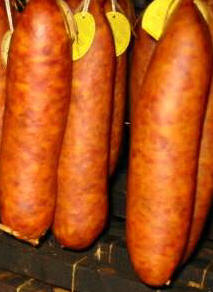
%20e.jpg)
... which comes over a fettuccini pasta (below left.) Marcia had Caille en crapaudine � la Campagnarde (quail braised in orange sauce and bread) (below right.)
%20e.jpg)
%20e.jpg)
For dessert Marcia had a brownie with vanilla sauce while I had vanilla and chocolate ice cream.
%20e.jpg)
%20e.jpg)
During dinner we learned that there are the police nationale and the police municipale sort of like our FBI and local police. The dinner was excellent except I don't think it was the best Boeuf Bourgogne I have ever had and that was a little disappointing. At 11:50 we took a taxi back to our hotel and got our Accor free drinks. I then worked on my photos and got to bed at 3 AM.
Kenneth J. Hoffer, MD
Dijon, France
Sent 2-10-13
If you enjoyed these travels or wish to add comments on the places we visited
Please Leave Me a Message by clicking the spinning @ sign below.

